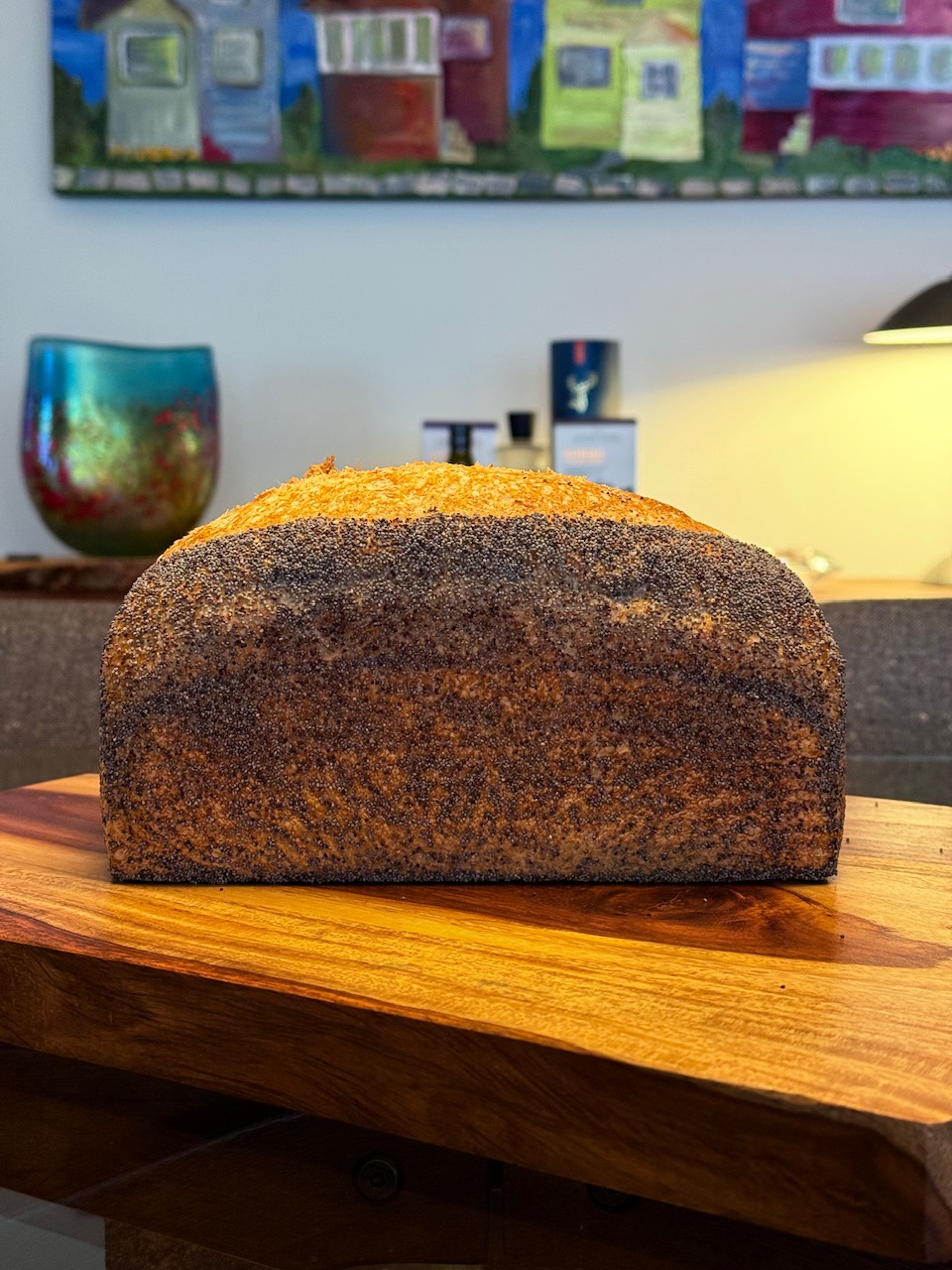
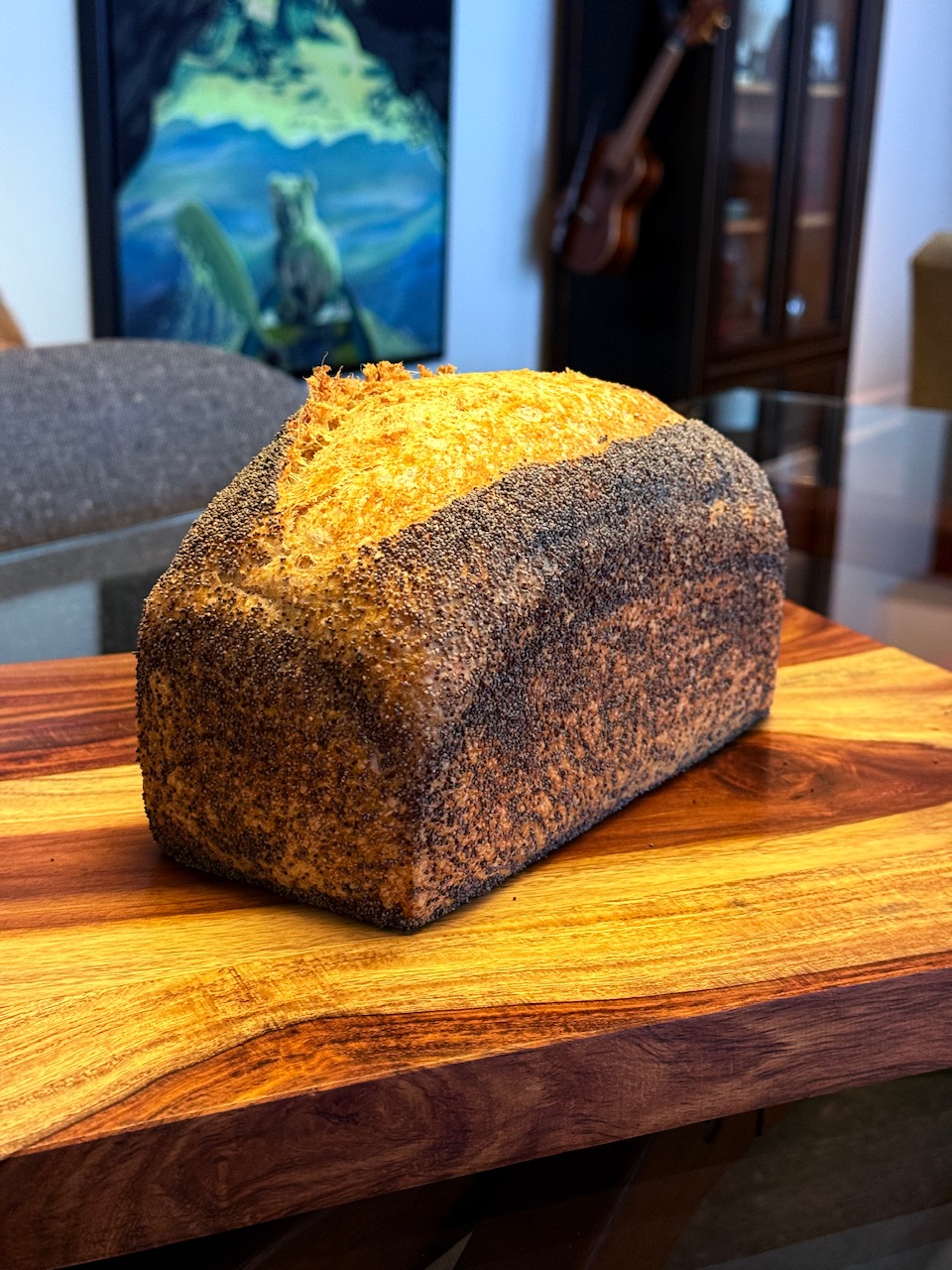
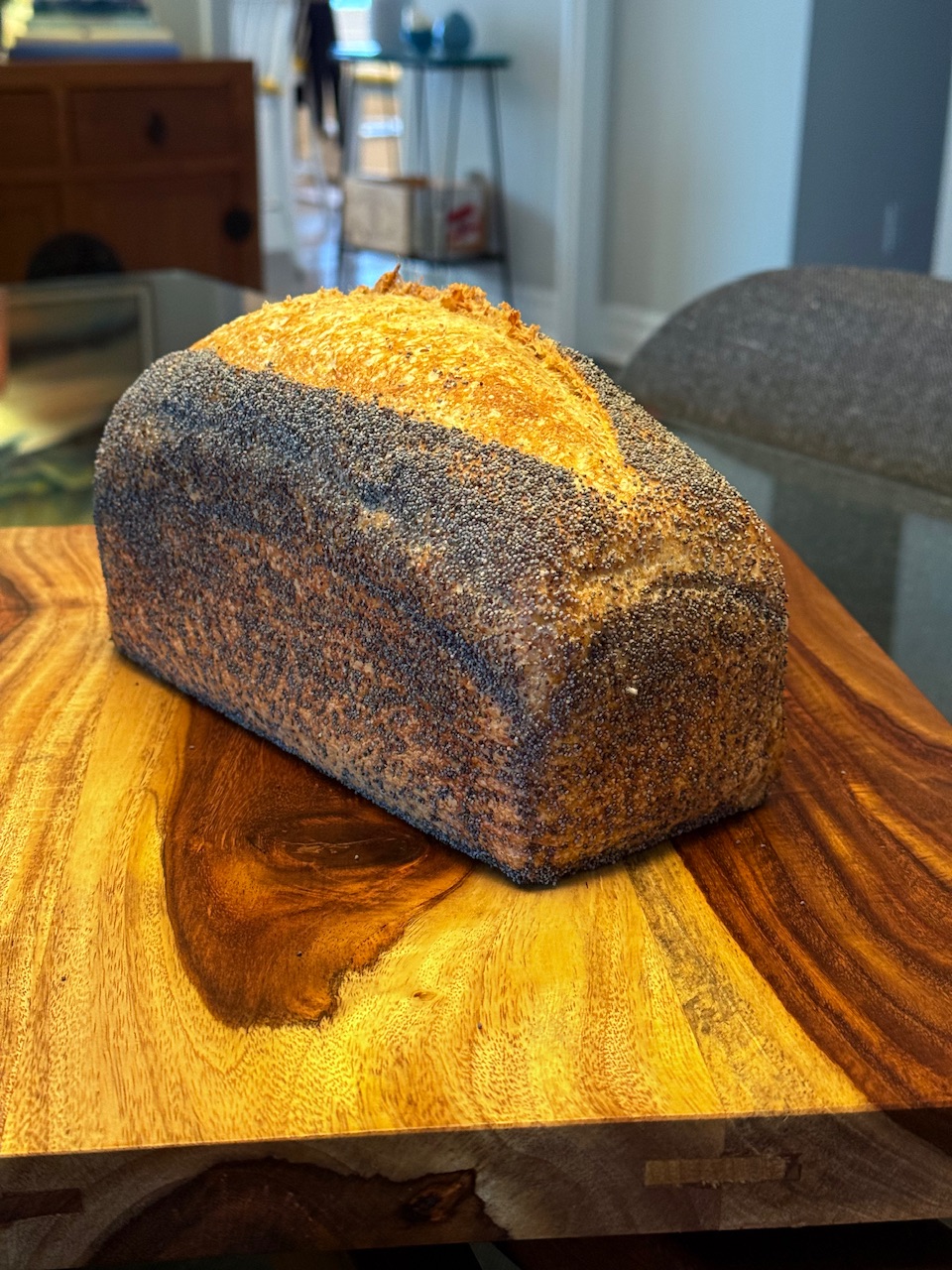
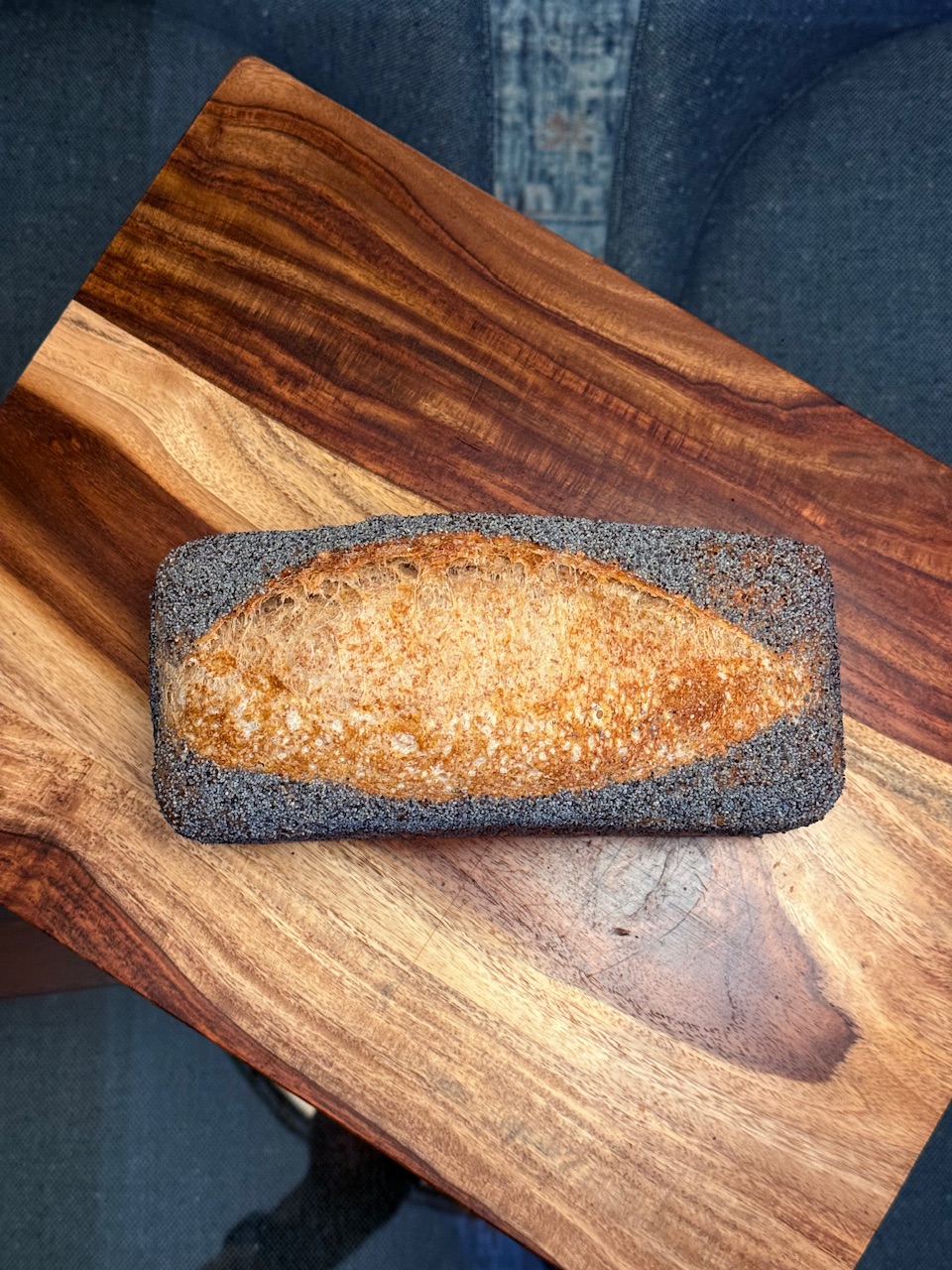
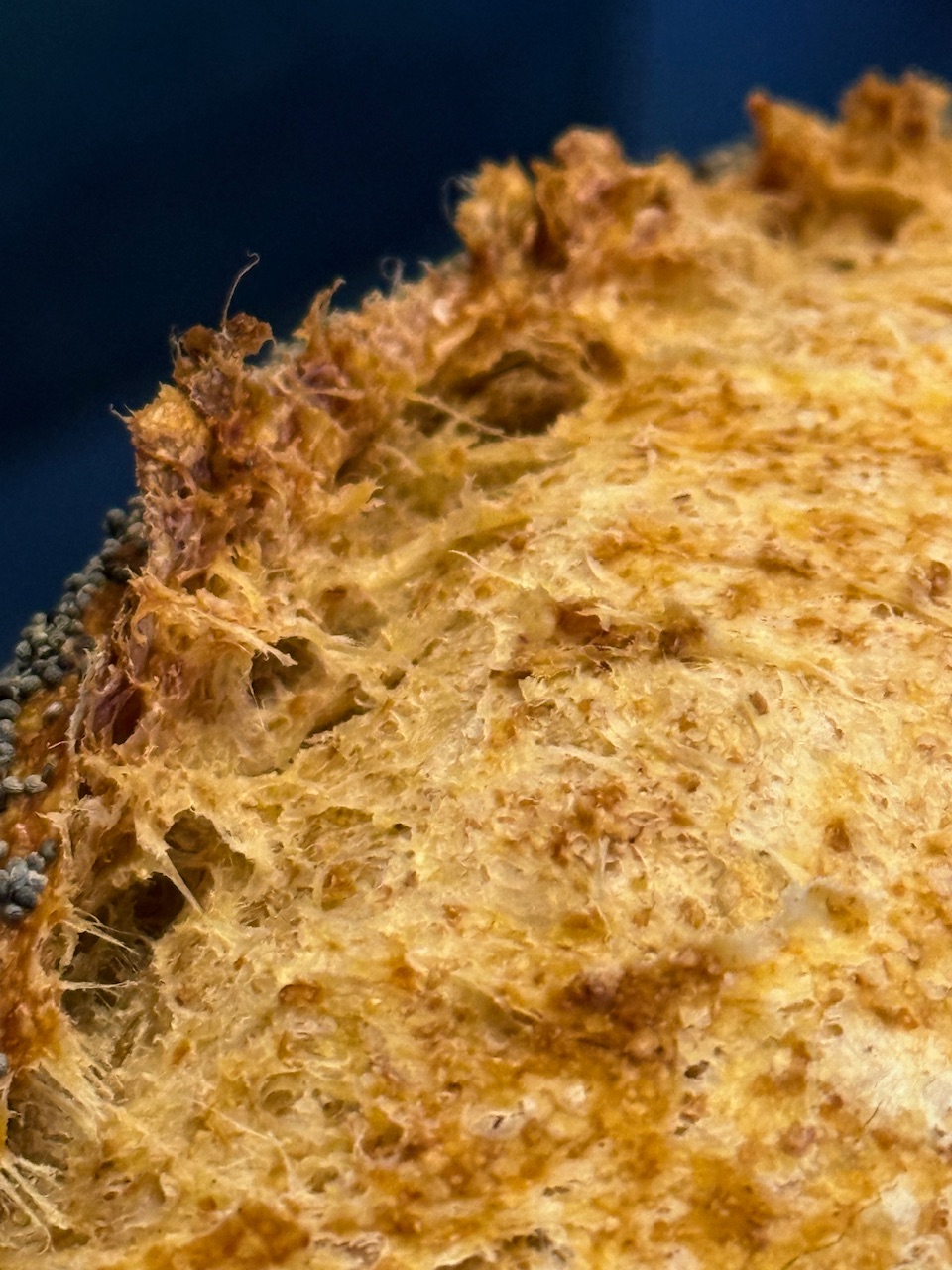
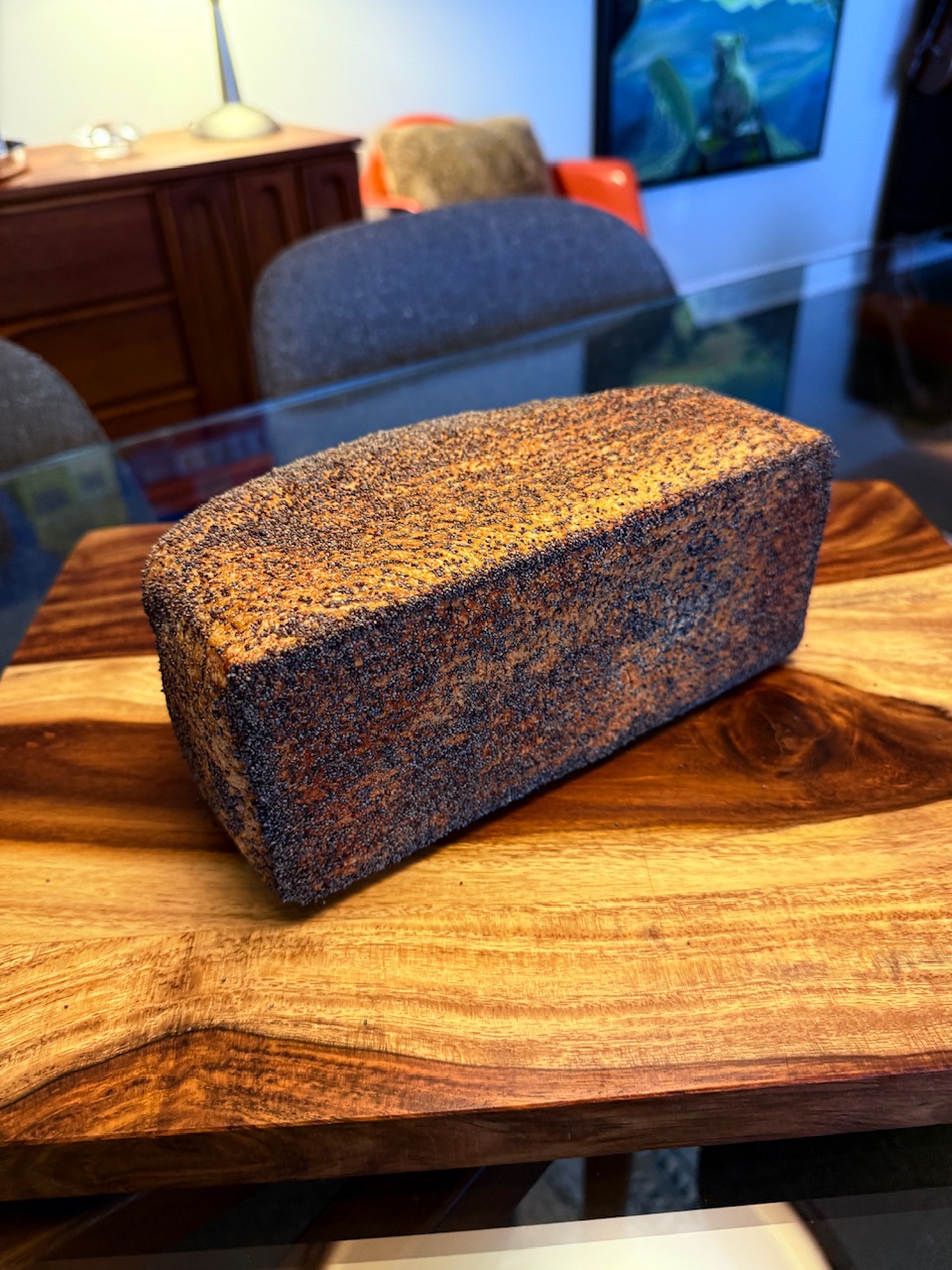
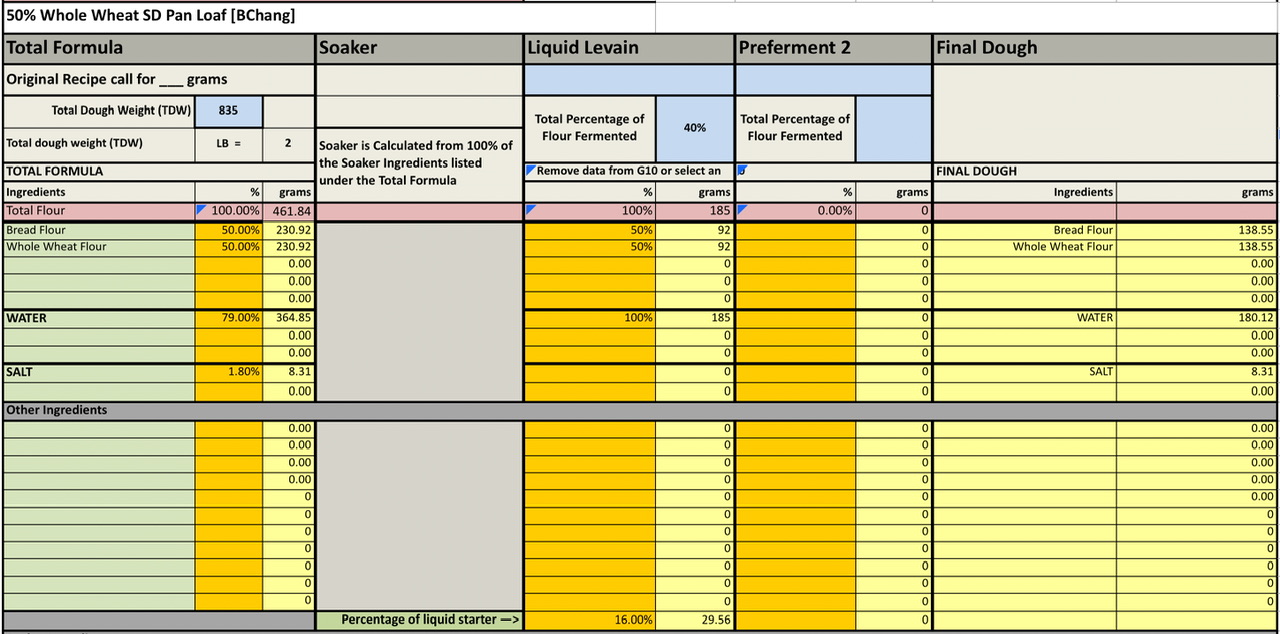
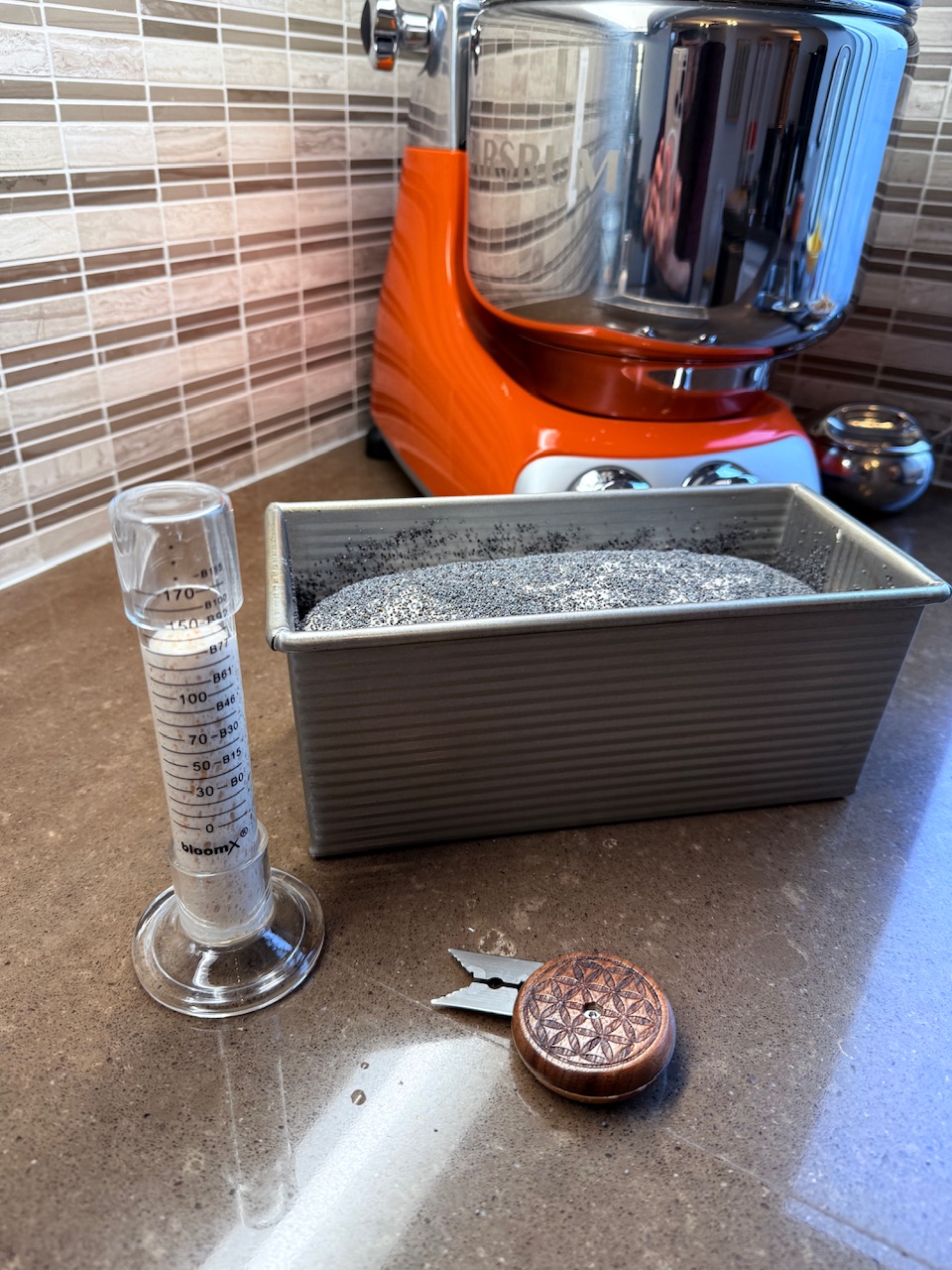
Still testing high percentage prefermented flour to obtain an open crumb. So this time stepped up the wholegrain to 50% of the total flour. The levain still contained 40% of the total flour at the same 1:1 ratio of whole wheat to bread flour as the final dough. I’m quite happy with how this turned out, but I think I could increase the hydration another 2% to see if that would open up the crumb even more. I’m really enjoying the poppyseed crusts and once again I added the seeds to the pan after buttering it.
Once the dough was developed, the total time of bulk at 82°F was just under two hours. Final proofing also at 82°F took only an hour and 50 minutes.
For 1 loaf in a 9x4x4” Pullman Pan
Overnight levain build, at 74°F about 10 hours to rise 3x.
In the morning add salt to water and dissolve. Add levain and mix.
Add flours and knead until good gluten development, I will use my Ankarsrum Assistent and mix until a good windowpane is achieved about 12 mins.
Remove dough from the bowl and do some slap and folds. Next set up aliquot jar.
Bulk fermentation at 82ºF.
End bulk when aliquot jar reaches 40% rise.
Shape the dough into a batard and place in buttered Pullman pan. Optional, sprinkle poppyseeds on the bottom and sides of the pullman pan.
Shape and allow an initial final proof warm until 100% rise in aliquot jar, start oven preheat 425ºF preparing for steam bake.
Allow the dough to rise until within 1 cm of the rim of the pan and then bake immediately or about 130% rise in the aliquot jar.
Once oven reaches 425ºF score top of dough and then brush with water. Optional sprinkle with seeds and then score. Transfer to oven and bake with steam for 25 mins. Vent the oven (remove steaming gear) rotate the pan and drop temperature to 350ºF. Bake for another 30 mins rotating as needed until browned. Remove from the pan and place directly on the rack baking for another 5-10 mins to firm up the crust if desired.
- Benito's Blog
- Log in or register to post comments
Overall happy with this bake, the crumb looks great to my eyes and the enhanced wheat flavours from 50% whole wheat are just great. The convenience of the process going so quickly is also great especially when there is nothing lost in flavour or texture.
Hope you give a high percentage pff a try in some of your bakes, I’d love to know the results.
Benny
Hi Benny,
I love the crumb you got on this bake!! Is this a new avenue of bakes you have started? How is the chew when compared to your tangzhong loaves? Thanks for sharing your work!!
Hi Jo, thank you for your comments they are appreciated. Yes I finally decided to test this idea of using a much higher percentage of prefermented flour. I had seen a couple of IG bakers say that they use this in their bakes to achieve an open crumb. I was never sure why it would, but a few of these bakes really get incredibly open beautiful crumb in their hearth loaves. Now I haven’t baked a hearth loaf in ages and maybe I should bake one again, but I love pan loaves for their ease of slicing and for making sandwiches.
In regards to the chew, these lean breads eat much more similarly to other lean sourdough breads that I have baked in the past. The crumb has more chew without being too chewy or tough. They are really good for sandwiches and toasted after being frozen.
I’m pretty cuffed with this method, and 3 for 3 is pretty good.
Benny
Good lord, Benny, your loaves look even more perfect time after time. I tip my hat!
TomP
Tom you are far too kind, thank you. Practice and repetition really helps me improve.
Benny
Wonderful loaf, Benny. It looks nice and light, great for sandwiches. Well done. Thanks for the formula as I'll give this one a go. I'll adjust up the dough weight as my Pullman is the larger one.
Cheers,
Gavin.
Thank you Gavin, I hope you do give this a try and please let me know how it turns out. I’d love to know how reproducible the results are.
Benny
Beautiful bake Benny!
Nice ear, nice open crumb, and I love the seeded crust, they're a bit messy but they add a nice crunch. I'll bet it tasted great.
Tony
I agree with you on how messy the seeds are and also that they do add a lot to a bread Tony. Thank you for your kind comments as always.
Benny
Stellar bake Benny, the recipe that can't be improved is still getting better and better. I too want to give this one a try.
I did have the thought that putting all/most of the whole grain into the preferment might be something to try just to see if such a fabulous outcome could still be achieved like that.
For two reasons: putative softening of bran, but also nutritional reasons - phytic acid is reduced by long fermentation. Are these factors that you think about?
The science behind PA is mostly coming from in vitro studies though, and you managed a very fine crumb so clearly bran isn't a problem here, so perhaps the benefit of doing this isn't so clear either.
-Jon
Jon, thank you for your comments. I had thought about making the levain all whole wheat. I changed my mind at the last minute thinking that it could cause the bread to be more acidic tasting with the bran acting as a buffer and allowing the LAB to produce more acids during fermentation.
I hadn’t given phytic acid a thought in a long time, but what little I know about it, it seems that LAB produce phytases that help reduce the binding capacity of phytic acid. Also, lower pH also helps speed up the action of phytases. Phytic acid acts as a chelator of minerals so reducing the binding capacity should make the minerals more bioavailable and absorbable into our bodies in the GI tract. What I don’t know is how much time is a factor. If the dough is acidic enough and the LAB population is large enough, does the dough need to ferment for a long time for the phytases work, or is a few hours enough? You pose a great question and it isn’t something I was considering I have to admit.
I believe that phytic acid concentration is greater in the bran and germ portions of grain. It would make most sense, if you’re wanting to make the minerals more bioavailable, in this formula to make the levain fully whole wheat to give the phytases more time to reduce the phytic acid.
Definitely something to think about. I’m not sure that I have it all correct.
Benny
During WW II, Ireland experienced severe food shortages. the Irish government progressively required that flour for bread be made from higher and higher extraction flour until it went to 100% extraction. After that, it was found that the incidence of rickets, calcium deficiency, and TB increased in children, even with fortified flours. Apparently extraction in the range of roughly 90 - 92% did not result in these problems.
https://journals.sagepub.com/doi/full/10.1177/03324893231161928
Since I read this paper I prefer to sieve out whole grain flour to around 90% extraction (or less, depending on how the screen and flour play together). Of course, if you get enough of these ingredients elsewhere then 100% extraction will be less of a nutritional problem.
TomP
These nutritional issues related to phytic acid are far more significant in places where there is poor nutrition overall. In first world countries we will get enough of our mineral nutrients from other sources and don't need to rely on bread for it. In places with food shortages, it is far more important that the nutritional impact of everything they eat is maximized.
Benny
Great looking loaf 🍞 Already added poppy seeds to my shopping list 😉
Not sure if with this amount of WW you can get even more irregular crumb alveolation and bigger alveoli. The crumb looks pretty dang good to me.
Maybe if you add the whole amount of WW to the starter as suggested in the previous comments. This will of course change the acidity profile. On the other hand you still have the main dough fermentation, the final proof and last but not least the temperature with impact on the acidity.
I’m certain all not mad at the crumb that’s for sure! That’s the fun of baking bread isn’t it? There are so many things that you can change that can alter the final bake.
Benny
Wonderful loaf and exemplary write up, Benny. Thank you for sharing. Like the others who have posted, it is definitely the kind of loaf I would like to add to my baseline breads, so will also be trying it out. Been looking for a good straight forward recipe like this one.
I know you are aiming for an open crumb, so wondering how you go about figuring out the right balance between BF, proving, and putting in the oven times/rises.
This is definitely going into my bookmarks!
When I think about putting something new together, I look through my previous formulas as a starting point and make adjustments. Then depending on how it turns out, make more changes that I think might improve the bake. For this one I looked at previous lean 50-60% WW sourdough batards that I had baked and how they turned out. I do like to end bulk at 40% for many of my bakes as I find it challenging to shape when the dough is more fermented than that. Also shaping earlier can lead to a more irregular crumb. Although I’m hoping for an open crumb, I still like it to be somewhat more even than what many IG bakers like to have.
Anyhow, by doing a series of similar breads I can learn a lot about how to improve it, so repetition is something I like to do. Keeping detailed notes on each bake really helps.
Benny
The crumb looks like lace! You’ve definitely achieved a stunning loaf and with the excellent write up it should be a great inspiration to others to make a move in this direction of increasing the levain amount.
I have been increasing my home milled flour amount with each bake and been very pleased with the flavor profile.
Congratulations! 🎉 🙏 c
Thank you for your very kind comments Caroline. Maybe someday if I ever move to a place with a much larger kitchen I’ll get a mill, but for now I’ll have to continue to get what I can find in stores. Fortunately there are some that sell local organic stoneground flours.
Benny
There are more old mills reopening around here out in the countryside so that’s exciting . Tom gave me Kamut from one of them when we met up in April . If I request the whole grain they have said they will set it aside for me. I just have to find the time to drive to their open mill days.
Did you sell your place in Ft Lauderdale? What will you do now in Winter?
Yes Caroline, we were lucky enough to have closed on the sale of our apartment in Fort Lauderdale last month. There were a lot more places on the market and far fewer purchasers than usual, so we feel very fortunate to have found buyers at a price that we were happy with. We will travel to other places now and have more variety in the winter I guess, the world is our oyster.
Benny
That’s why we have never purchased a 2nd home. We like to see new places and want to be able to choose and change plans accordingly. So glad it worked out for you both.
Our daughter in law’s parents are in Niagara on the Lake . We are meeting up with them while our son and grandson and daughter in law visit in late July for a week. Our grandson loves to visit up there and does sailing and kayak lessons on the Lake. We look forward to seeing him demonstrate his skills, he’s 13 .
Beautiful crumb for sure. Quick question on your method that’s confusing me. You bulk to 40% and then shape and look for a 100% rise but you then say you look for 130% rise before baking. Which is it?
Thanks 🙏🏻
Thank you Ian, pretty happy with this bake. The reference to 100% rise is approximately when to start the oven preheat. 130% rise is when I started to bake. Hope that helps.
Benny
Yes that makes more sense. Definitely going to give this one a try soon.
Ian
You've had more success than me with open crumb SD loaves, Benny, especially with high wholewheat content. Do you think the high levain percentage helps - and what is the theory behind it?
And what about the crumb? Is it soft and easy eating? I've sometimes found non-enriched high WW tin loaves can have a tough, chewy crumb.
Lance
Thank you Lance, I’m so pleased that these first three bakes using 40% pff seemed to have helped achieve an open crumb. I’m not entirely sure what is going on, but I suppose it might just be the momentum and speed of gas production in the dough. I’ve had some open crumb at my usual 9% pff and lean doughs but never quite as open as these. It is nice to be able to do this when wanted.
This bread style eats differently than my Hokkaido milk breads which are enriched and thus fluffy, shreddable and soft to eat. This lean bread has a nice chew to the crumb yet it isn’t excessively chewy per se.
Benny
I love the results you're getting with the higher pff%, Benny. My SD bakes tend to have a really high pff% for scheduling reasons, but on the odd occasion that I have used low pff% for experimental reasons, I've always found the resulting loaves to have a less elastic crumb -or a more tender mouthfeel depending on how you look at it - and a somewhat more pronounced sourness. These have generally been lean doughs, though.
Did you notice anything different about the taste at all?
I think I was expecting that the bread would have higher acid tang in the flavour than breads that I have made before with lower pff. In fact my palate agrees with yours that the high pff ends up tasting more mildly sour, which I much prefer. In the breads that I've used very low pff and took exceptionally long to ferment, I always found them more tangy. In terms of texture, these recent bakes have all had a pleasant chew to the crumb in stark contract to my enriched Hokkaido milk breads which were always so soft and shreddable.
I really should have been testing the pH out of curiousity.
Benny